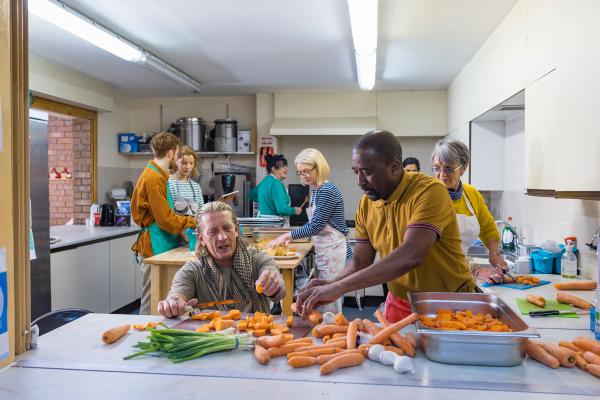Overview
The White House Conference on Hunger, Nutrition, and Health — held in September 2022 — renewed national attention and issued a call to action to end hunger and reduce the prevalence of chronic disease in the United States by 2030.
Food is Medicine approaches that focus on integrating consistent access to diet- and nutrition- related resources are a critical component to achieve this goal. The approaches are increasingly present across many communities and systems. There’s also increasing federal investment and action to support Food is Medicine approaches in a variety of settings.
Building on this collective energy, the Department of Health and Human Services (HHS) developed a Food is Medicine initiative in response to a congressionally funded initiative in fiscal year 2023. This congressional action directed the Secretary of HHS, in consultation with other federal agencies, to develop and implement a federal strategy to reduce nutrition-related chronic diseases and food insecurity to improve health and racial equity in the United States. This includes diet-related research and programmatic efforts that will increase access to Food is Medicine initiatives.
Learn about Food is Medicine framing language and principles.
Understanding the Connection Between Food and Health
Access to nutritious food is critical to health and resilience. Food is Medicine is a concept that reaffirms this connection, recognizing that access to high-quality nourishment is essential for well-being. By supporting the production of and facilitating access to nutritious food across a health continuum and range of settings, approaches to Food is Medicine support immediate and long-term resources for people, communities, and systems.
Nutrition Security and Health: By the Numbers
- Approximately 33.8 million people live in food-insecure households.1
- Household food insecurity affected 12.5 percent of households with children in 2021.1
- About half of all American adults — or 117 million individuals — have 1 or more preventable chronic disease, many of which are related to poor-quality eating patterns and physical inactivity. These include cardiovascular disease, high blood pressure, type 2 diabetes, some cancers, and poor bone health.2
- Lower food security is associated with higher probability of chronic disease diagnosis — including hypertension, coronary heart disease, hepatitis, stroke, cancer, asthma, diabetes, arthritis, COPD (chronic obstructive pulmonary disease), and kidney disease.3
- Nearly $173 billion a year is spent on health care for obesity alone.4
HHS Approach
HHS will work collaboratively with federal partners and external organizations and communities to develop resources that can be used to advance Food is Medicine approaches across the country.
Our plans include the following steps:
1. Listen to Communities and Implementation Partners
- HHS will engage with a variety of external partners across the nation to better understand challenges and opportunities to advance Food is Medicine models.
- HHS will conduct an environmental scan of existing Food is Medicine models, initiatives, and federal, state, and local regulations and policies.
2. Cultivate Partnerships with Cross-Sector Leaders
- HHS and federal colleagues will build a public-private learning collaborative to support collectively measuring and demonstrating data-driven insights.
3. Develop Resources to Support Broad Uptake
- HHS will develop an evidence-based implementation resource that can serve as a practical guide to help communities understand how to design and implement effective Food is Medicine pilots and policy-sustaining programs.
- HHS will create a unified, applied-measures registry to support and create a transparent catalog of high-value, reliable measures.
- HHS will facilitate knowledge exchange and continue to identify opportunities for federal action to advance a robust Food is Medicine landscape.
Please note that this webpage will be updated with tools and resources as the initiative progresses.
Examples of Current HHS Food is Medicine Activities and Practice Resources
- Innovations in Medicaid programs: Section 1115 of the Social Security Act gives the Secretary of Health and Human Services authority to approve experimental, pilot, or demonstration projects, offering states an avenue to test new approaches in Medicaid that differ from what is required by federal statute. The Biden-Harris Administration has encouraged states to propose innovative Section 1115 waivers that expand coverage, reduce health disparities, and/or advance whole-person care (including addressing health-related social needs). HHS recently approved groundbreaking Medicaid initiatives in Massachusetts and Oregon and Arkansas that gave the states new authority to test coverage for evidence-based nutritional assistance and medically tailored meals.
- Indian Health Service (IHS) Produce Prescription Pilot Program: American Indian and Alaska Native (AI/AN) people are disproportionately impacted by food insecurity when compared to non-Native people. They’re also more likely to live in areas with low or no access to fresh foods than any other racial or ethnic group. Produce prescription programs have been shown to increase access to nutritious foods in communities at risk for food insecurity. In 2023, IHS awarded a total of $2.5 million in funding to help decrease food insecurity in Native communities. Of that funding, 5 tribes and tribal organizations received $500,000 each in 2023 to implement a produce prescription program in their communities.
- Stimulating Research: In June 2022, the National Institutes of Health (NIH) released a Notice of Special Interest (NOSI): Stimulating Research to Understand and Address Hunger, Food and Nutrition Insecurity to encourage research on the efficacy of interventions that address nutrition security and the mechanisms of food insecurity on a variety of health outcomes. In April 2023, as part of a government-wide collaboration that includes 12 federal agencies and offices, NIH released a Request for Information on Food is Medicine Research Opportunities to gather input on the following topic areas: 1) Research, 2) Community Outreach and Engagement, 3) Education and Training, 4) Provision of Food is Medicine Services and Activities, and 5) Coverage for Services.
- Supporting Best Practices: The Administration for Community Living developed a public-facing resource with information to support partners’ design and implementation of Food is Medicine approaches, such as medically tailored meals, for older adults.
